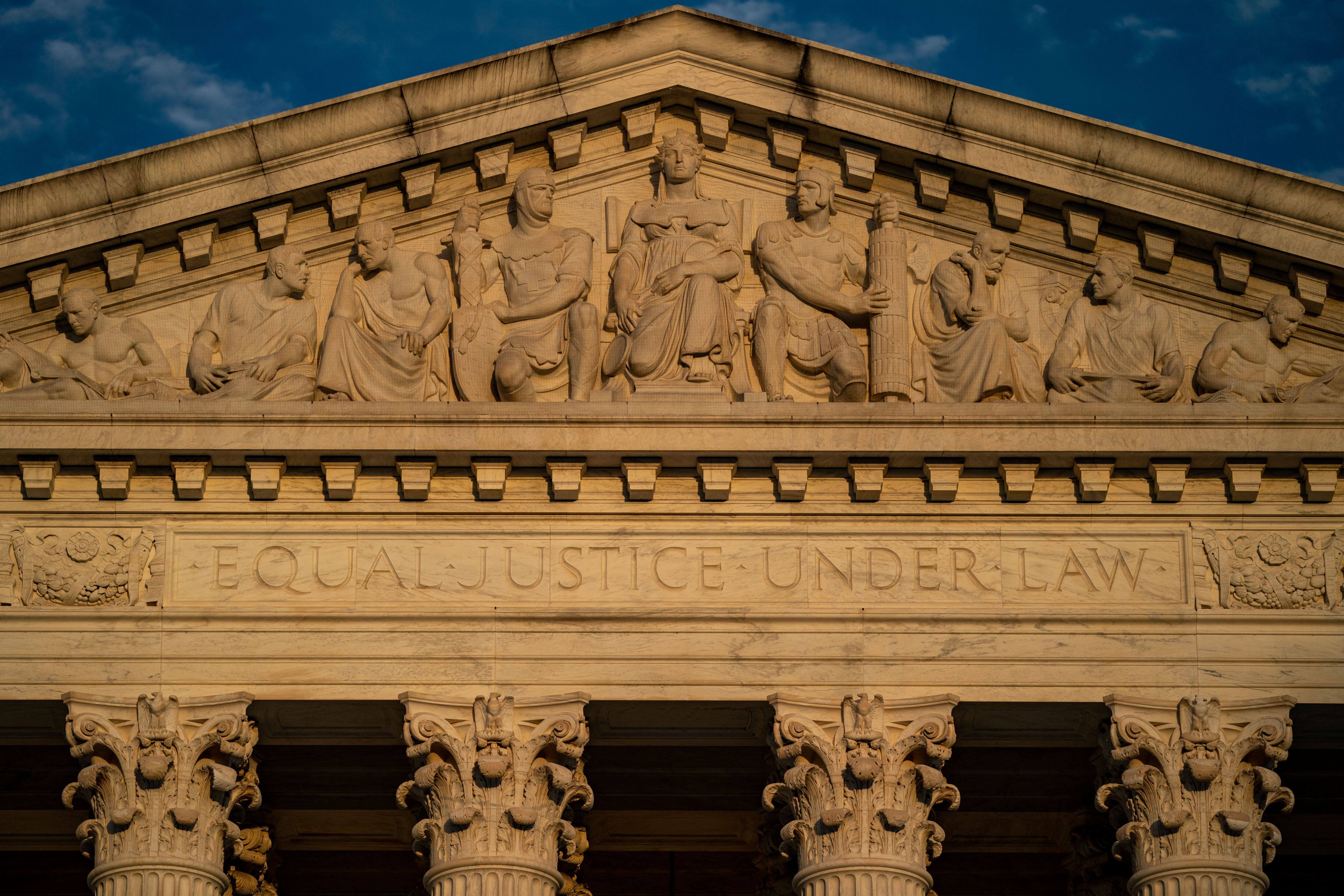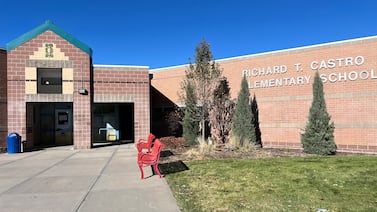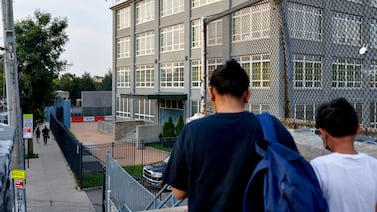Monday could mark the beginning of the end for affirmative action in higher education.
The U.S. Supreme Court will hear oral arguments that day in two cases challenging the use of race in college admissions. The court’s decision earlier this year to hear the cases, which seek to overturn prior rulings that upheld affirmative action, suggests the longstanding policy might be on its way out.
The case doesn’t directly involve schools that educate kindergartners through 12th graders, yet its outcome could alter those students’ post-grad trajectories: If selective universities can no longer consider race in admissions, they are likely to enroll fewer Black and Latino students.
But the higher-ed cases could also portend changes to K-12 schools, where efforts to promote racial diversity already face legal challenges. Advocates fear that if the Supreme Court ends race-conscious admissions in higher education, K-12 integration efforts could be next.
“I think anybody who cares about preserving any semblance of diversity in educational institutions, be they K-12 or higher ed, is paying attention to this case,” said Stefan Lallinger, a desegregation expert who helped form a peer-support network for districts pursuing integration.
As the closely watched case begins, here’s what you need to know:
The ruling shouldn’t immediately affect K-12 schools
The central question before the court is whether colleges and universities should be able to use race as one of many factors in selecting students and pursuing educational diversity.
The cases stem from lawsuits against Harvard and the University of North Carolina brought by Students for Fair Admissions, a group led by conservative legal activist Edward Blum. The group alleged that the admissions process at Harvard discriminates against Asian American students by holding them to a higher standard than other applicants, and that UNC’s process discriminates against Asian American and white students by giving preference to Black, Latino, and Native American applicants.
The institutions denied the allegations and lower courts ruled in their favor, saying the universities had met the strict standards for race-conscious admissions policies established through four decades of Supreme Court decisions. The plaintiff appealed the rulings to the Supreme Court, which agreed in January to hear the two cases.
Because the cases turn on legal precedents specific to higher education, their outcome should not directly affect K-12 schools with programs meant to increase student diversity, said Genevieve Bonadies Torres, an attorney at the the Lawyers’ Committee for Civil Rights Under Law, which is representing some students and alumni in the Supreme Court cases.
However, she warned that opponents of race-conscious admissions might use the higher-ed ruling to attack K-12 integration efforts.
“The ultimate goal of these groups is to scare and chill and litigate against diversity programs,” she said.
Colleges and K-12 schools follow different rules about race
Colleges and universities have more leeway than K-12 schools to use race in pursuit of diversity.
In rulings stretching from 1978 to 2016, the Supreme Court has set a high bar for race-conscious admissions in higher education, or affirmative action. Institutions may not set racial quotas, they must consider race-neutral approaches, and they may only use race as one factor among many in a holistic review of each applicant.
In the majority opinion in Grutter v. Bollinger, a 2003 case in which the court upheld affirmative action by a 5-4 vote, Justice Sandra Day O’Connor cited two reasons for allowing the “narrowly tailored use of race in admissions:” Students benefit from diversity, and courts should defer to universities on academic decisions, including whom to admit.
Because of the “expansive freedoms of speech and thought associated with” higher education, O’Connor wrote, “universities occupy a special niche in our constitutional tradition.”
Four years later, the court declined to grant the same leeway to K-12 schools.
In a landmark 2007 ruling, the court ruled 5-4 to strike down two school districts’ voluntary integration plans. The goal of diversity, or “racial balance,” is not a sufficient reason for public school districts to assign students to schools based on their race.
“The way to stop discrimination on the basis of race is to stop discriminating on the basis of race,” Chief Justice John Roberts memorably wrote.
In a concurring opinion, Justice Anthony Kennedy agreed with the judgment but insisted that districts can take some voluntary steps to combat segregation. Whether by redrawing attendance lines or strategically locating schools, districts can try to promote diversity through race-conscious policies so long as they operate at a general but not individual level, Kennedy wrote. (The ruling did not affect court-ordered desegregation plans.)
But even though Kennedy’s concurrence left room for some voluntary integration, the threat of lawsuits has made most districts wary of walking that line.
There are more than 13,000 districts nationwide, but a 2020 report could identify only 119 districts with active integration plans. (The researchers also found 66 charter school organizations with plans.) The vast majority of the plans consider students’ socioeconomic status but don’t factor in race — even in the general way that Kennedy allowed.
For that reason, even if the Supreme Court one day banned any consideration of race in district diversity plans, relatively few schools would be affected.
“My first instinct is that this decision wouldn’t necessarily change the landscape that much for K-12 school districts,” said Halley Potter, a senior fellow at the Century Foundation think tank, who co-authored the 2020 report. “Frankly, there are so few voluntary race-based integration plans in K-12 already.”
The end of affirmative action could lead to K-12 legal challenges
Still, if the Supreme Court’s conservative majority rules against affirmative action, as is widely expected, advocates worry it could invite challenges to the few remaining K-12 integration plans.
The most likely targets are elite public high schools with selective admissions policies. Many such schools have historically admitted few Black or Latino students, prompting some school districts — including Boston, New York City, and San Francisco — to adopt diversity plans.
Critics have attacked the high school diversity plans and affirmative action along similar lines. They say the schools have improperly tried to engineer a “racial balance” of students, failed to consider other ways to pursue diversity, and discriminated against Asian American and white applicants.
The “pernicious practice of racial balancing has spread to K-12 education, where it is now depriving children of spots at some of the best public schools in the nation solely because of their race,” reads a friend of the court brief supporting the challenge to affirmative action. Submitted by the Pacific Legal Foundation, a conservative group that has won more than a dozen Supreme Court cases, the brief argues that race should play no role in either college or K-12 admissions.
Several K-12 education groups filed briefs supporting affirmative action, arguing that students at every level benefit from diversity. One brief urged the court to allow colleges and school districts to continue using race to promote diversity according to the standards set in prior rulings.
“The Court need not, and should not, revisit either longstanding precedent,” said the brief submitted by national associations representing school boards, principals, and counselors.
But even if the court’s affirmative action ruling does not address K-12 schools, future rulings might.
A case currently in federal court challenges the diversity plan at Thomas Jefferson High School for Science & Technology, a selective public school in Fairfax County, Virginia. The prestigious school overhauled its admissions policies in 2020 following years of complaints that it enrolled very few Black and Latino students.
Last year, the Pacific Legal Foundation helped Coalition for TJ, a group that includes parents and alumni, file a lawsuit against the district. Similar to the Harvard case, the lawsuit accuses the district of discriminating against Asian Americans, whose enrollment dropped sharply after the admissions change. But unlike Harvard, the high school did not explicitly consider each applicant’s race, instead using other measures — such as admitting the top-performing students from each middle school — to boost diversity.
“That is still every bit as much of a violation of someone’s Equal Protection rights as if you sit in front of an audience and said, ‘I’m discriminating on the basis of race,’” said Erin Wilcox, a lawyer at the Pacific Legal Foundation, who called the school’s diversity plan “proxy discrimination.” (The district says its admission system is based on merit, not race.)
Lallinger, the integration advocate, called the foundation’s argument extreme because it suggests that even the goal of racial diversity is suspect.
“Essentially they’re arguing that any effort to address historical discrimination against Black and Latino students is inherently unconstitutional,” he said, “because, they argue, admissions is a zero-sum game.”
In oral arguments last month, a federal appeals court appeared skeptical of the case against the district.
If the group behind the challenge loses, it could appeal to the Supreme Court. And if the high court rules against affirmative action in higher education, that could bolster the case against diversity efforts in K-12 schools, Wilcox said.
“It will take away this reliance on diversity as a compelling government interest,” she said, adding that in her group’s ongoing legal campaign against school diversity plans, “That will certainly be a supporting precedent that we will use.”
Patrick Wall is a senior reporter covering national education issues. Contact him at pwall@chalkbeat.org.







